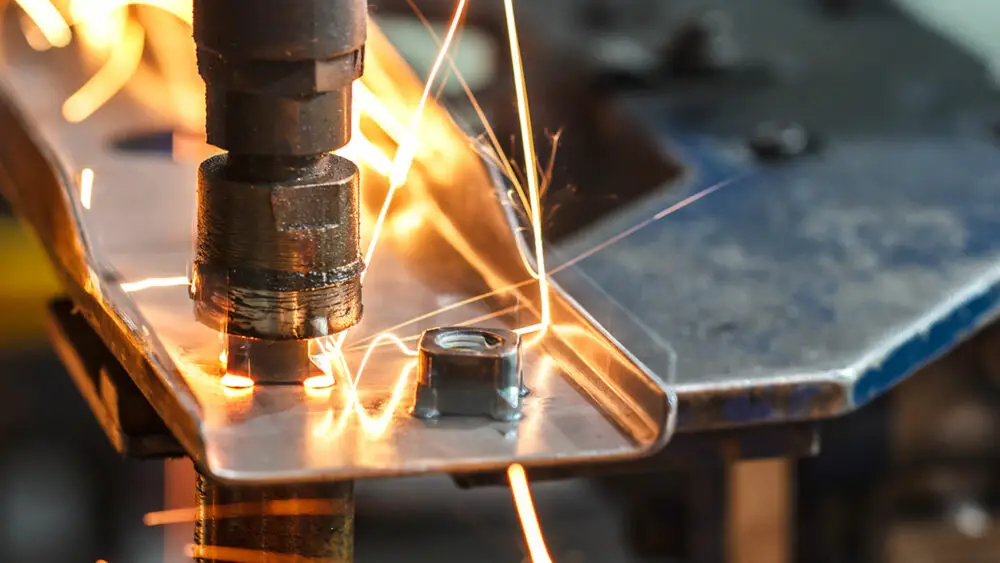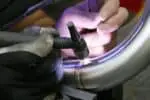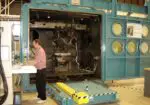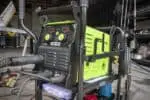Resistance welding is the connecting of metals by exerting pressure and transferring current through the metal region to be welded over an extended period of time. Automotive, Aerospace and Industrial- are all industries where resistance welding is suitable and is frequently employed.
The primary advantage of resistance welding is that no extra materials are required to form the connection, making this procedure incredibly cost effective. There is no need for filler metal, flux, or shielding gas in resistance welding.
How does Resistance Welding Work?
The electrodes on the welding machine press two pieces of metal together to make excellent electrical contact. Then the electric current is run through them, heating them until they melt where they come into contact together.
When the current is switched off, the molten metal from the two parts solidifies, providing a solid metallic link between the two components.
The name Resistance Welding refers to the electrical attribute of resistance of the metal being welded, which causes heat to be created when current passes through it.
Resistance welding is classified into numerous categories, like spot and seam, projection, flash, and upset welding, which differ principally in the types and shapes of weld electrodes used to exert pressure and conduct current.
Here is a youtube video on how Resistance welding operates. We thought it might be helpful along with reading this article –
Types of Resistance Welding
1.) Spot Welding- Spot Welding is the most basic kind of resistance welding in which the work components are kept together by anvil face pressure.
When the copper electrodes come into touch with the work item, current begins to flow through it. The workpiece material introduces some resistance into the current flow, resulting in local heat production.
2.) Seam Welding- Also known as continuous spot welding, seam welding uses a roller type electrode to conduct electricity through work parts. The rollers are first brought into contact with the work item.
These rollers are subjected to a high amp current. This causes the contact surfaces to melt and produce a weld connection. This results in a continuous weld junction.
3.) Projection Welding- Similar to spot welding, projection welding produces a dimple, also called a dent on work components at the desired weld area.
The work parts are now held between electrodes, and a tremendous quantity of electricity passes through them.
On welding plates, a little amount of pressure is exerted via the electrode. The current flows through the dent, melting it, and the pressure forces the dent to flatten and produce a weld.
4.) Flash Welding- It is another form of resistance welding that is used in the steel industry to weld tubes and rods.
Two work pieces to be welded are clamped in the electrode holders throughout this operation, and a strong pulsed current in the region of 100,000 amps is given to the workpiece material. In this case, two electrode holders are used, one fixed and one movable.
5.) Upset Welding- Just like other resistance welding processes, upset welding employs heat created by resistance to the passage of welding current, as well as force to press the workpieces together over a fixed length of time.
While Upset Welding is comparable to Flash Welding, the workpieces are already in strong contact with one another, hence no flashing occurs. Pressure is applied prior to the onset of the current and is maintained until the operation is completed.
Advantages of Resistance Welding
1.) It is a quick procedure.
2.) Because the resistance welding technique does not require high temperatures, it is suitable for welding soft materials such as copper, aluminum, brass, nickel, and so on.
3.) It provides for exact placement of the filler metal while causing no harm to the base material.
4.) It has more ductility than other standard connecting techniques.
5.) It is perfect for producing intricate structures with little deformation or breaking.
6.) Because of the low voltage, it provides greater operator safety.
7.) The heat is concentrated, the operation is quick, and no filler metal is required.
8.) Because there is no heat transmission to the workpiece, the workpiece does not melt during the welding process.
9.) Resistance welding is therefore highly beneficial for creating products with complicated forms or components that must preserve structural integrity while being welded together.
10.) In addition, it has high corrosion resistance and hence eliminates failure due to weathering effects over lengthy periods of time as compared to other common connecting methods.
11.) It is a quick and low-cost way of connecting metals.
12.) It generates no sparks or flames.
13.) Because the procedure requires less expertise, it may be readily mechanised and automated.
Since we have read in detail about the advantages Resistance welding has to offer, now let us understand some of its disadvantages.
Disadvantage of Resistance Welding
1.) It produces more slag, which can be hazardous to individuals in the vicinity of the weld.
2.) Resistance welding is incapable of cutting through thicker metals such as stainless steel.
3.) When some materials, such as copper, are heated during resistance welding, their characteristics might be harmed.
4.) It is more expensive than other procedures since it requires a lot of energy and chemicals to complete the task.
5.) The resistance welding machine is extremely complex, containing numerous elements such as a heavy transformer, electrodes and heavy conductors for carrying high currents, an electrode force applying mechanism such as a pneumatic cylinder and its supply, and a heavy machine structure to support large forces.
6.) Some resistance welding methods are exclusively applicable to lap joints.
7.) Tensile and fatigue strength of spot welds are poor.
8.) Because the equipment is heavy, it cannot be moved easily.
9.) The cost of equipment is expensive.
Factors Impacting Resistance Welding Results
1.) Welding current
This is the most important aspect of resistance welding. Welding current is commonly determined by a power of squares, or I2.
When the welding current is increased, the size of the welded nugget increases proportionally. Expulsions and electrode degradation will occur if too much current is used.
2.) The Welding force
To allow the current to flow smoothly, welding force is required to compress the workpieces at the welding zones. When you start the welding current, using a low welding power may result in expulsions.
Using a higher welding force, on the other hand, will result in a larger contact area, resulting in reduced contact resistance and current density.
3.) Material characteristics
The resistance welding dynamics are based on the fact that all materials change when the temperature varies. Heat generation and heat transport are influenced by the welding material’s resistivity and thermal conductivity.
4.) The coatings on the surface
Surface coatings are often used to guard against corrosion or as a substrate for additional surface treatment. Coatings can also be used by welders to help them weld complicated material combinations. In this scenario, the coatings are strategically placed to equally balance the heat on the weld contact.
5.) The resistance to contact
Resistance to contact diminishes with increasing temperature and correspondingly with increasing pressure in resistance welding. Rough surfaces are common in all metals. As a result, increasing the welding force raises the contact pressure.
6.) The Welding duration
The heat generated during resistance welding is proportional to the welding time. To obtain a weld, a welder will need a minimum welding current and welding duration.
A weld’s development is generally influenced by two things- heat transmission from the weld zone to the base metals and electrodes and heat loss from the free surfaces to the surrounding environment.
Applications of Resistance Welding
Resistance welding is employed in situations where extended production runs and constant conditions are required. Welding is done by operators who generally load and unload the welding equipment and activate the switch that starts the weld.
Resistance welding procedures are most commonly used in the automobile sector, followed by the appliance industry. Many businesses employ resistance welding to produce a wide range of goods composed of thinner gauge metals.
In the steel industry, this sort of welding is also utilised to make pipe, tubing, and smaller structural components.
It offers the benefit of creating a large volume of work at a rapid pace while requiring no filler materials. Welds are repeatable, and high-quality welds are the norm.
Metals that can be welded using Resistance Welding technique
Specific resistance welding procedures are connected to weldable metals, weldable thicknesses, and joint design. Here is a table to help you out.
| Metals | Weldable or not |
| Magnesium | Weldable |
| Nickel | Weldable |
| Monel | Weldable |
| Precious metals | Weldable |
| Aluminum | Weldable |
| Low carbon steel | Weldable |
| Steel alloys | Possible, however not popular |
| Low alloy steel | Weldable |
| Stainless steel | Weldable |
Conclusion
Resistance welding is one of the unique kinds of welding techniques which is quite different from TIG and MIG techniques. It sure does have its limitations, but its advantages overpowers all its cons.
However, you should know how to employ resistance welding and what type of metals that can be welded with the resistance welding technique.







